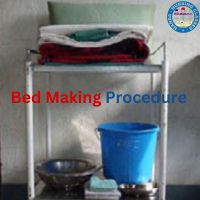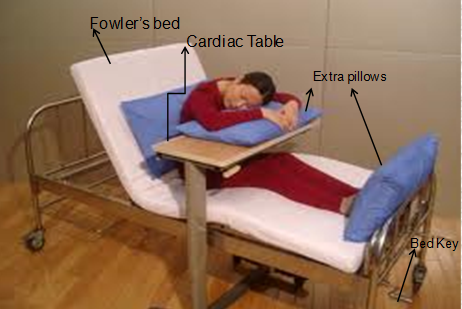Introduction
Nail care procedure in nursing involves the maintenance and hygiene of a patient’s nails. It is an essential aspect of overall patient care, promoting comfort, and cleanliness, and preventing potential complications. This procedure is typically performed by nurses or nursing assistants. we will provide nursing students with a simple yet comprehensive guide to the nail care procedure, including its definition, purpose, indications, contraindications, advantages and disadvantages, equipment, procedure, nursing responsibilities, and a concluding remark.

Nail Care Definition
Nail care procedure refers to the systematic trimming, cleaning, and maintenance of a patient’s nails to ensure they are clean, well-groomed, and free from potential risks or infections.
Nail Care Purpose
The primary purpose of nail care procedure is to maintain good hygiene and prevent potential complications related to the nails. Regularly trimming and cleaning the nails, the procedure helps prevent the accumulation of dirt, bacteria, and fungi. Proper nail care also reduces the risk of injuries, such as scratches or
self-inflicted wounds, that can occur due to long or jagged nails.
Nail Care Indications
Nail care is indicated for all patients, especially those with limited mobility or compromised immune systems. It is particularly important for individuals who are bedridden, elderly, or unable to perform nail care independently. Patients with diabetes, peripheral vascular disease, or conditions affecting blood circulation may also require regular nail care to prevent complications.
Nail Care Contraindications
There are a few contraindications to consider when performing nail care. Patients with bleeding disorders, such as hemophilia, should be cautious during nail trimming to avoid excessive bleeding. Additionally, individuals with ingrown nails, severe nail infections, or open wounds around the nail bed should have their nail care performed by a healthcare professional to prevent further complications.
Advantages and Disadvantages of Nail Care
Advantages
Proper nail care offers several advantages. It promotes cleanliness and reduces the risk of infections caused by bacteria and fungi. Regular nail trimming also prevents scratches or injuries that can lead to infections. Furthermore, nail care can enhance a patient’s overall comfort, hygiene, and self-esteem, contributing to their overall well-being.
Disadvantages
While the benefits of nail care are significant, there are few potential disadvantages to be aware of. In rare cases, improper nail trimming or excessive force during the procedure can cause pain, bleeding, or injury. It is crucial to use appropriate techniques and tools to minimize the risk of complications.
Equipment
The following equipment is typically used for nail care procedure :
- Nail clippers or scissors (with rounded edges)
- Nail file or emery board
- Basin or bowl with warm soapy water
- Clean towels or disposable wipes
- Antiseptic solution (optional)
- Cotton balls or swabs
- Moisturizing lotion (optional)
Nail Care Procedure
- Begin by washing your hands and gathering all necessary equipment.
- Position the patient comfortably, ensuring good lighting and accessibility to their nails.
- Explain the procedure to the patient, addressing any concerns or questions they may have.
- Fill a basin or bowl with warm soapy water and ask the patient to soak their hands or feet for a few minutes to soften the nails.
- If the patient has any existing nail polish, remove it using a gentle nail polish remover.
- Carefully dry the patient’s hands or feet with a clean towel or disposable wipes.
- Start trimming the nails straight across, avoiding curving or cutting too close to the skin. Use nail clippers or scissors with rounded edges to prevent injury.
- Smooth the edges and shape the nails using a nail file or emery board.
- Gently clean under the nails using a cotton ball or swab dipped in warm soapy water or antiseptic solution if necessary.
- After the procedure, apply moisturizing lotion if desired, massaging it into the patient’s hands or feet to promote hydration.
- Dispose of any waste materials properly and clean the equipment as per the healthcare facility’s guidelines.
Nursing Responsibilities
During the nail care procedure, nurses have several responsibilities:
- Assessing the patient’s overall nail condition and any signs of infection or abnormalities.
- Explaining the procedure to the patient and obtaining their consent.
- Ensuring patient comfort and privacy during the procedure.
- Using proper infection control measures, such as hand hygiene and wearing gloves.
- Employing gentle and cautious techniques to prevent injury or pain.
- Documenting the procedure, including any findings or changes in the patient’s nail condition.
Must read- Bed Making Procedure | Definition | Purpose | Principal | Types of Beds.
Conclusion
Nail care procedure is an important aspect of patient care, promoting hygiene, comfort, and prevention of potential complications. By following proper techniques and using appropriate tools, nurses can effectively perform nail care and contribute to the overall well-being of their patients. Regular nail care helps maintain good hygiene, reduces the risk of infections, and enhances the patient’s self-esteem and comfort.
FAQs
Here are some frequently asked questions (FAQs) on the topic of nail care procedures:
What is a nail care procedure?
A nail care procedure involves the maintenance and grooming of the nails to ensure they are healthy, clean, and presentable. It typically includes trimming, shaping, and moisturizing the nails and surrounding skin.
How often should I trim my nails?
The frequency of nail trimming depends on individual nail growth rates and personal preference. In general, nails should be trimmed regularly, usually every 1-2 weeks, to prevent them from becoming too long or prone to breakage.
What is the correct way to trim nails?
To trim nails properly, use sharp, clean nail clippers or scissors to cut straight across the nail, avoiding rounded edges to prevent ingrown nails. After trimming, gently file the nails to smooth any rough edges.
How should I shape my nails?
Nails can be shaped into various styles, including square, oval, round, or almond. Use a nail file to shape the nails according to your preference, following the natural curve of the nail and avoiding excessive filing, which can weaken the nails.
What is cuticle care, and why is it important?
Cuticles are the thin, protective layers of skin at the base of the nails. Cuticle care involves gently pushing back the cuticles and moisturizing them to keep them soft and prevent dryness and cracking. Proper cuticle care helps maintain nail health and appearance.
How can I strengthen my nails?
To strengthen nails, maintain a balanced diet rich in vitamins and minerals, such as biotin, calcium, and iron. Use nail strengthening treatments or protective coatings, and avoid excessive exposure to water and harsh chemicals.
What should I do if my nails are brittle or splitting?
If nails are brittle or splitting, try using moisturizing nail creams or oils to hydrate the nails and cuticles. Avoid using harsh nail products and limit exposure to drying agents, such as acetone-based nail polish removers.
Can I do a professional-quality manicure at home?
With the right tools and techniques, it’s possible to achieve a professional-quality manicure at home. Invest in high-quality nail care products, follow proper hygiene practices, and take your time to ensure a neat and polished finish.
How can I prevent nail infections?
To prevent nail infections, keep nails clean and dry, avoid biting or picking at nails and cuticles, and use clean, sanitized nail tools. If you notice signs of infection, such as redness, swelling, or pus, seek medical attention promptly.



